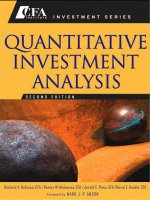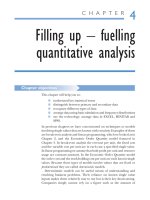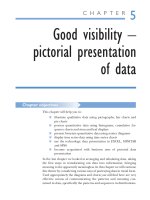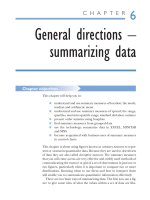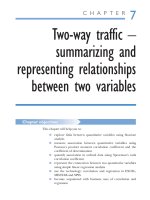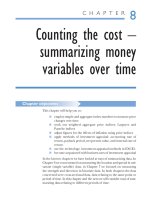Quantitative Methods for Business chapter 15 potx
Bạn đang xem bản rút gọn của tài liệu. Xem và tải ngay bản đầy đủ của tài liệu tại đây (115.28 KB, 16 trang )
CHAPTER
Taking short cuts –
sampling methods
15
Chapter objectives
This chapter will help you to:
■ appreciate the reasons for sampling
■ understand sampling bias and how to avoid it
■ employ probabilistic sampling methods and be aware of their
limitations
■ use the technology: simple random sampling in MINITAB and
SPSS
■ become acquainted with business uses of sampling methods
A population is the entire set of items or people that form the subjects
of study in an investigation and a sample is a subset of a population.
Companies need to know about the populations they deal with: popu-
lations of customers, employees, suppliers, products and so on. Typically
these populations are very large, so large that they are to all intents and
purposes infinite.
Gathering data about such large populations is likely to be very
expensive, time-consuming and to a certain extent impractical. The scale
of expense can be immense; even governments of large countries only
commit resources to survey their entire populations, that is, to conduct a
census, about every ten years.
The amount of time involved in surveying the whole population
means that it may be so long before the results are available that they
are completely out of date. There may be some elements within the
Chapter 15 Taking short cuts – sampling methods 467
population that simply cannot be included in a survey of it; for instance,
a car manufacturer may want to conduct a survey of all customers buying
a certain model three years before in order to gauge customer satisfac-
tion. Inevitably a number of those customers will have died in the period
since buying their car and thus cannot be included in the survey.
To satisfy their need for data about the populations that matter to them
without having to incur great expense or wait a long time for results com-
panies turn to sampling, the process of taking a sample from a population
in order to use the sample data to gain insight into the entire population.
Although not as accurate as the results of a population survey, sample
results can be precise enough to serve the purposes of the investigation.
The downside of sampling is that many different samples can be taken
from the same population, even if the samples are the same size. You
can work out the number of samples of n items that could be selected
from a population of N items:
We can use this to work out the number of samples of size 6 that could
be selected from a very small population of just 20 items:
You can imagine that the number of samples that could be selected from
a much larger population will be so very large as to border on the infinite.
Each of the samples you could select from a population inevitably
excludes much of the population, so sample results will not be precisely
the same as those from the entire population. There will be differences
known as sampling errors between sample results and the results of a
population survey and furthermore different samples will yield different
results and hence different sampling errors.
In this chapter you will find details of a variety of sampling methods,
but before we look at them we need to consider what companies might
look for in sampling, and what they would prefer to avoid.
15.1 Bias in sampling
The point of selecting a sample from a population is to study it and use
the results to understand the population. To be effective a sample
should therefore reflect the population as a whole. However, there is
Number of samples size 6
20!
6! 14!
38,760ϭϭ
Number of samples size
!
!( )!
n
N
nN n
ϭ
Ϫ
468 Quantitative methods for business Chapter 15
no guarantee that the elements of the population that are chosen for the
sample will collectively reflect the population. Even if the population is
quite small there will be an enormous number of combinations of elem-
ents that you could select in a sample. Inevitably some of these samples
will represent the entire population better than others.
Although it is impossible to avoid the possibility of getting an unrep-
resentative sample, it is important to avoid using a sampling method
that will almost invariably lead to your getting an unrepresentative
sample. This means avoiding bias in selecting your sample.
Effective methods of sampling are those that minimize the chances
of getting unrepresentative samples and allow you to anticipate the
degree of sampling error using appropriate probability distributions.
Such methods should give every element of the population the same
chance of being selected in a sample as any other element of the popula-
tion, and consequently every possible sample of a certain size the same
chance of selection as every other sample of the same size.
If some elements of the population have a greater chance of being
selected in a sample than others, then we have bias in our sampling
method. Bias has to be avoided as the samples that can result will be
extremely unlikely to reflect the population as a whole and such mis-
leading results may have disastrous consequences.
Example 15.1
Packaged potato crisps are sold by the million every day of the week; it is a huge market.
You might think that the company that pioneered the product would by now be a very
large and successful one, but you would be wrong; after their initial success they ran
into problems that eventually lead to their being taken over. Occasionally the company
that now owns the brand re-launches it as a retro product, with the distinctive small blue
paper twist of salt in the crisp packet.
A key factor in the decline of the potato crisp pioneers was product quality. The com-
pany received a consistent stream of complaints from customers about the number of
charred and green-tinged crisps. The company directors knew of these complaints but
were baffled by them; they knew their product was good because they tasted a sample
taken from the production line every day with their morning coffee.
The problem for the directors was the method used to take the samples from the pro-
duction line. The sample was selected by the shopfloor staff, who knew they were destined
for the boardroom and quite understandably ensured that only the best were selected. The
samples provided for the directors were therefore biased; the charred and green crisps that
their customers wrote about had no chance of being selected in the samples taken for the
directors.
Chapter 15 Taking short cuts – sampling methods 469
The most effective way of avoiding bias in sample selection is to use
probabilistic methods, which ensure that every element in the popula-
tion has the same chance of being included in the sample. In the next
section we will look at sampling methods that yield samples from which
you can produce unbiased estimators of population measures, or param-
eters such as a mean or a proportion.
In Example 15.1 the company directors were completely misled by the
bias in the selection of their samples of potato crisps. Biased samples will
mislead, no matter how large the samples are; in fact, the larger such sam-
ples are, the greater the danger of misrepresentation since it is always
tempting to attach more credibility to a large sample.
The directors were reluctant to take action to deal with a problem they were convinced
did not exist. This made it easier for competitors to enter the market and the initial
advantage the pioneers enjoyed was lost.
Example 15.2
In the 1936 presidential election in the USA the incumbent Democrat, Franklin
Roosevelt, faced the Republican governor of Kansas, Alfred Landon. Roosevelt was
associated with the New Deal programme of large-scale public expenditure to alleviate
the high level of unemployment in the depression of the time. Landon on the other
hand wanted to end what he considered government profligacy.
The prominent US weekly magazine of the time, The Literary Digest, conducted one of
the largest polls ever undertaken to predict the result of the election. After analysing
the returns from over 2 million respondents, the Digest confidently predicted that
Landon would win by a large margin, 56% to 44%. The actual result was that Roosevelt
won by a large margin, obtaining 60% of the vote. How could the Digest poll have been
so wrong?
The answer lay in the sampling method they used. They sent postcards to millions of
people listed in telephone directories, car registration files and magazine subscription
lists. The trouble was that in the USA of 1936 those who had telephones and cars and
subscribed to magazines were the better-off citizens. In restricting the poll to such
people, who largely supported Landon, the poll was biased against the poor and
unemployed, who largely voted for Roosevelt.
470 Quantitative methods for business Chapter 15
Example 15.3
Strani Systems have 2000 employees in the UK. The HR director of the company wants
to select a sample of 400 employees to answer questions about their experience of working
for the company. How should she go about using simple random sampling?
The population in this case consists of all the Strani employees in the UK. The sampling
frame would be a list of employees, perhaps the company payroll, with each employee
15.2 Probabilistic sampling methods
Perhaps the obvious way of giving every element in a population the
same chance of being selected in sample is to use a random process
such as those used to select winning numbers in lottery competitions.
Lotteries are usually regarded as fair because every number in the popu-
lation of lottery numbers has an equal chance of being picked as a
winning number.
15.2.1 Simple random sampling
Selecting a set of winning numbers in a lottery is an example of simple
random sampling, whether the process involves elaborate machines or
simply picking the numbers from the proverbial hat. You can use the
same approach in drawing samples from a population.
Before you can undertake simple random sampling you need to estab-
lish a clear definition of the population and compile a list of the elements
in it. In the same way as all the numbers in a lottery must be included if
the draw is to be fair, all the items in the population must be included for
the sample we take to be random. The population list is the basis or
framework of our sample selection so it is known as the sampling frame.
Once you have the sampling frame you need to number each elem-
ent in it and then you can use random numbers to select your sample.
If you have 100 elements in the population and you need a sample of
15 from it you can take a sequence of 15 two-digit random numbers
from Table 4 on page 620 in Appendix 1 and select the elements for
the sample accordingly; for instance if the first random number is 71
you take the 71st element on the sampling frame, if the second ran-
dom number is 09 you take the ninth element and so on. If the ran-
dom number 00 occurs in the sequence you take the 100th element.
Chapter 15 Taking short cuts – sampling methods 471
Simple random sampling has several advantages; it is straightforward
and inexpensive. Because the probability of selection is known it is pos-
sible to assess the sampling error involved and ensure that estimates of
population parameters based on the sample are unbiased.
A potential disadvantage of simple random sampling is that in a case
such as Example 15.3 the sample may consist of elements all over the
country, which will make data collection expensive. Another is that
whilst it is an appropriate method for largely homogenous populations,
if a population is subdivided by, for instance, gender and gender is an
important aspect of the analysis, using simple random sampling will not
ensure suitable representation of both genders.
15.2.2 Systematic random sampling
A faster alternative to simple random sampling is systematic sampling.
This involves selecting a proportion of elements from the sampling
frame by choosing elements at regular intervals through the list. The
first element is selected using a random number.
numbered from 1 to 2000. The HR director should then take a sequence of four-digit
random numbers such as those listed along row 7 of Table 4:
1426 7156 7651 0042 9537 2573 and so on
She does face a problem in that only two of the random numbers, 1426 and 0042, will
enable her to select an employee from the list as the others are well above 2000. To get
round this she could simply ignore the ones that are too high and continue until she
has 400 random numbers that are in the appropriate range. This may take considerable
time and she may prefer to replace the first digit in each number so that in every case
they are either 0 or 1, making all the four-digit numbers in the range 0000 to 1999
(0000 would be used for the 2000th employee):
Change 0, 2, 4, 6, 8 to 0
Change 1, 3, 5, 7, 9 to 1
By applying this to the figures from row 7 of Table 4 she would get:
1426 1156 1651 0042 1537 0573
Now she can use every number in the sequence to select for the sample.
Example 15.4
How can the HR director in Example 15.3 use systematic sampling to select her sample
of 400 employees?
472 Quantitative methods for business Chapter 15
As well as being cheap and simple, systematic sampling does yield
samples with a definable sampling error and therefore able to produce
unbiased estimates. This is true as long as the population list used to
select the sample is not drawn up in such a way as to give rise to bias. In
Example 15.4 a list of employees in alphabetical order should not
result in bias but if most employees worked in teams of five, one of
whom was the team leader and the list of employees was set out by
teams rather than surnames, then the systematic sampling of every fifth
employee would generate a sample with either all or none of the
employees selected being team leaders.
Systematic sampling has the same disadvantages as simple random
sampling; expensive data collection if the sample members are widely
dispersed, and the possibility of sub-sections of the population being
under-represented.
15.2.3 Stratified random sampling
One problem with both sampling methods we have looked at so far is
that the samples they produce may not adequately reflect the balance
of different constituencies within the population. In the long run this
unevenness will be balanced out by other samples selected using the
same methods, but this is little comfort if you only have the time or
resources to take one sample.
To avoid sections of a population being under-, or for that matter
over-represented you can use stratified random sampling. As the name
implies, the sample selection is random, but it is structured using the
sections or strata in the population. The starting point is to define the size
of the sample and then decide what proportion of each section of the
population needs to be selected for the sample. Once you have decided
how many elements you need from each section, then use simple ran-
dom sampling to choose them. This ensures that all the sections of the
population are represented in the sample yet preserves the random
Since there are 2000 employees she needs to select every fifth employee in the list that
constitutes the sampling frame. To decide whether she should start with the first, second,
third, fourth or fifth employee on the list she could take a two-digit random number and
if it is between 00 and 19 start with the first employee, between 20 and 39 the second,
between 40 and 59 the third, between 60 and 79 the fourth, and between 80 and 99 the
fifth. The first two-digit number at the top of column 9 of Table 4 is 47, so using this she
should start with the third employee and proceed to take every fifth name after that.
Chapter 15 Taking short cuts – sampling methods 473
The advantage of stratified random sampling is that it produces
samples that yield unbiased estimators of population parameters whilst
ensuring that the different sectors of the population are represented.
The disadvantage in a case like Example 15.5 is that the sample consists
of widely dispersed members and collecting data from them may be
expensive, especially if face-to-face interviews are involved.
15.2.4 Cluster sampling
If the investigation for which you require a sample is based on a popu-
lation that is widely scattered you may prefer to use cluster sampling.
This method is appropriate if the population you wish to sample is
composed of geographically distinct units or clusters. You simply take a
complete list of the clusters that make up your population and take a
random sample of clusters from it. The elements in your sample are all
the individuals in each selected cluster.
Example 15.5
The 2000 UK employees of Strani Systems are based at six locations; 400 work in Leeds,
800 in Manchester, 200 in Norwich, 300 in Oxford, 100 in Plymouth, and 200 in Reading.
How can the HR director in Example 15.3 use stratified random sampling to choose her
sample of 400 employees?
A sample of 400 constitutes 20% of the workforce of 2000. To stratify the sample in the
same way as the population she should select 20% of the employees from each site; 80 from
Leeds, 160 from Manchester, 40 from Norwich, 60 from Oxford, 20 from Plymouth and
40 from Reading. She should then use simple random sampling to choose the sample
members from each site. For this she would need a sampling frame for each location.
Example 15.6
How can the HR director from Example 15.3 use cluster sampling to select a sample of
employees?
She can make a random selection of two or maybe three locations by simply putting the
names of the location in a hat and drawing two out. All the employees at these locations
constitute her sample.
nature of the selection and thus your ability to produce unbiased estima-
tors of the population parameters from your sample data.
474 Quantitative methods for business Chapter 15
The advantages of cluster sampling are that it is cheap, especially if
the investigation involves face-to-face interviews, because the number
of locations to visit is small and you only need sampling frames for the
selected clusters rather than the entire population.
The disadvantages are that you may well end up with a larger
sample than you need and there is a risk that some sections of the
population may be under-represented. If Leeds and Manchester
were the chosen clusters in Example 15.5, the sample size would
be 1200 (the 400 employees at Leeds and the 800 at Manchester),
a far larger sample than the HR director requires. If the overall
gender balance of the company employees in Example 15.5 is
40% male and 60% females yet this balance was 90% male and
10% female at the Norwich and Reading sites there would be a
serious imbalance in the sample if it consisted of employees at those
two sites.
15.2.5 Multi-stage sampling
Multi-stage is a generic term for any combination of probabilistic sam-
pling methods. It can be particularly useful for selecting samples from
populations that are divided or layered in more than one way.
A rather more sophisticated approach would be to make the probability that a
location is selected proportionate to its size by putting one ticket in the hat for
every 100 employees at a location – four tickets for Leeds, eight for Manchester
and so on.
As an alternative to drawing tickets from a hat, she could follow the approach we used
in section 12.4 of Chapter 12 to simulate business processes and employ random numbers
to make the selections in accordance with the following allocations:
Random number
Location allocation
Leeds 00–19
Manchester 20–59
Norwich 60–69
Oxford 70–84
Plymouth 85–89
Reading 90–99
Chapter 15 Taking short cuts – sampling methods 475
Example 15.6
The HR director from Example 15.3 likes the idea of cluster sampling as it will result in
cost savings for her investigation, but she wants to avoid having a sample of more than
400 employees. How can she use multi-stage sampling to achieve this?
She can use cluster sampling to select her locations and then, rather than contact all
the employees at each site, she could use stratified sampling to ensure that the sample
size is 400. For instance, if Leeds and Manchester were selected the 1200 employees at
those sites constitute three times as many as the HR director requires in her sample so
she should select one-third of the employees at each site; 133 at Leeds and 267 at
Manchester. She could use either systematic or simple random sampling to choose the
sample members.
The advantage of multi-stage sampling is that you can customize
your approach to selecting your sample; it enables you to benefit from
the advantages of a particular method and use others alongside it to
overcome its disadvantages. In Example 15.6 the HR director is able
to preserve the cost advantage of cluster sampling and use the other
methods to keep to her target sample size. Like other probabilistic
methods it produces results that can be used as unbiased estimators of
population parameters.
15.3 Other sampling methods
Wherever possible you should use probabilistic sampling methods, not
because they are more likely to produce a representative sample (which
is not always true) but because they allow you to make a statistical evalu-
ation of the sampling error and hence you can use the results to make
predictions about the population the sample comes from that are statis-
tically valid. Doing this with samples obtained by other methods does not
have the same validity.
Why then is it worth looking at other methods at all? There are sev-
eral reasons: some populations that you might wish to investigate simply
cannot be listed, such as the potential customers of a business, so
it is impossible to draw up a sampling frame; secondly, some of these
methods are attractive because they are convenient; and thirdly, they
are used by companies and therefore it is a good idea to be aware of
them and their limitations.
476 Quantitative methods for business Chapter 15
15.3.1 Quota sampling
In one respect quota sampling is similar to stratified random sampling:
you start by working out what proportion of the population you want to
include in your sample and then apply that proportion to the sections
of the population to work out the quota of respondents needed from
each section of the population. You then fill each quota by finding
enough elements from each section of the population.
Example 15.7
How can the HR director from Example 15.3 use quota sampling to obtain a sample of
400 Strani employees?
Since she requires a sample that amounts to 20% of the workforce of 2000, she can
set a quota of 20% of the employees at each location; 80 of the 400 at Leeds, 160 of the
800 at Manchester, 40 of the 200 at Norwich, 60 of the 300 at Oxford, 20 of the 100 at
Plymouth and 40 of the 200 at Reading. She could then despatch her researchers to each
site and they could approach employees as they were leaving the staff restaurant after
their lunch. When the quota is filled they have completed the task, for instance, once the
researchers at Leeds have data from 80 employees at the site they have finished.
The advantages of quota sampling are that the resulting sample should
be representative, and that the process is cheaper and easier than using
stratified sampling. In addition there is no need to find named individu-
als, who may, once found, decline to participate. Quota sampling is par-
ticularly useful for sampling from large populations for which an
accurate sampling frame is unavailable, a situation that polling organ-
izations typically face.
The disadvantages are that it is susceptible to bias and the results from
quota samples are not unbiased estimators of population parameters as
the sample selection process is not based on probability. The bias might
arise inadvertently from the researcher; for instance in Example 15.7 a
young male researcher may well be disposed to approach young female
employees rather more than others.
15.3.2 Judgemental sampling
In judgemental sampling the selection of the sample is based entirely
on the expertise of the investigator, who uses their judgement to select
a sample they consider representative.
Chapter 15 Taking short cuts – sampling methods 477
The advantage of judgemental sampling is that it does allow you to
customize your approach to sample selection. The disadvantage is that
it is entirely subjective and non-random and as such does not yield
results that can be used to predict the features of the population with
any statistical rigour.
15.3.3 Snowball sampling
This method involves starting by finding a relatively few respondents
who have a particular feature of interest to the investigator and using
them to identify others who share the same feature. The sample ‘snow-
balls’ to include these others and perhaps yet more potential respond-
ents whom they identify.
Example 15.8
The HR director from Example 15.3 knows that the Reading workforce consists almost
entirely of younger women who have young children, whereas at other locations the
workforce is largely composed of older males with grown-up families. Given this, she
may judge that an appropriate sample would consist of all the employees at Reading
and samples of the workforce at other locations.
Example 15.9
The HR director from Example 15.3 is interested in promoting the health of their
employees by opening gyms on their premises. She may wish to ascertain the interest in
such a venture by obtaining a sample of employees who already use gyms. She could
simply ask around her contacts to identify a ‘starter’ group of respondents and through
them build up a sample.
Snowballing is a useful means of obtaining a sample of a population
that may be difficult to access by other means, such as small-scale build-
ing contractors. It is open to bias because the initial respondents or con-
tacts decide whose names to pass on to you and there is no valid way of
assessing the sampling error so any generalization from the results is
not statistically valid.
478 Quantitative methods for business Chapter 15
15.3.4 Convenience sampling
This method is very simple: samples are chosen purely on the basis of
accessibility.
Example 15.10
The HR director from Example 15.3 is based at Strani’s Manchester site. To select her
sample she sends an email to all the employees in the building where her office is situated
and invites them to a meeting where she asks them to complete a questionnaire.
Convenience sampling, as the name suggests, is easy and cheap. It
can be a useful means of conducting an initial exploratory investigation
but the sample is unlikely to be representative of the whole population
and results from it should certainly not be used for estimating population
parameters as they lack statistical validity.
15.3.5 Self-selection
This is sample selection by invitation; you might send an email or dis-
play a notice asking for people to participate in an interview or com-
plete a questionnaire. The advantages are that it is cheap and easy,
and what is more you are guaranteed to get willing respondents.
Unfortunately this approach to sampling is almost invariably prone
to bias; usually it is the people who have stronger feelings on
the issues under investigation who put themselves forward and the
sample composition is therefore biased against those with more
neutral views.
15.4 Using the technology: random sample
selection in MINITAB and SPSS
Random numbers play a key part in probabilistic sampling methods. You
can use EXCEL to generate streams of random numbers as described in
section 12.5.1 of Chapter 12. If you want a more direct approach to select-
ing random samples try the MINITAB and SPSS facilities described here.
Chapter 15 Taking short cuts – sampling methods 479
15.4.1 MINITAB
Suppose you want to select a random sample of 15 of the 40 applica-
tions submitted for a job. If you number each of the applications 1 to
40 you can use this procedure to select your sample:
■ Click the Calc button at the top of the screen and from the
pull-down menu that appears select Make Patterned Data.
Click Simple Set of Numbers on the sub-menu that comes up.
■ In the command window that appears type C1 in the space to
the right of Store patterned data in: then 1 in the space beside
From first value: and 40 in the space beside To last value:. The
default settings in the other spaces in the window (alongside
In steps of:, List each value, and List the whole sequence)
should be 1. If any are not, change them to 1. Click OK and
you should see a list of numbers from 1 to 40 now located in
column 1 of the worksheet.
■ Click the Calc button again and choose Random Data. From
the sub-menu that comes up pick Sample From Columns.
■ In the command window that appears type 15 in the space
between Sample and rows from column(s):, click in the space
beneath and type C1. In the space below Store samples in: type
C2 then click OK. The list of numbers that is now stored in
column 2 of the worksheet is the random selection the pack-
age has produced and you can use it to select from the num-
bered applications; if the number 34 appears in column 2 then
pick the 34th application and so on.
15.4.2 SPSS
If you want to use SPSS to help you select a random sample of 15 from
40 job applications use this procedure to select your sample:
■ Type the applicants’ names into a column of the worksheet.
■ Click the Data button at the top of the screen then choose
Select Cases.
■ In the command window that appears click the button
alongside Random sample of cases. Make sure that beneath
Unselected Cases Are the button beside Filtered is the
default selection, and if not choose it, then click the Sample
button.
480 Quantitative methods for business Chapter 15
■ In the Select Cases: Random Sample window that comes up
click the small button to the left of Exactly then type 15 and
40 respectively in the empty spaces in the phrase Exactly—
from the first—cases. Click on Continue then OK in the
Select Cases window. In the worksheet you should see a new
column headed filter in which each cell has either 0 or 1. A
1 alongside an applicant indicates that that application should
be included in the sample, a 0 that it should not. There should
be as many ones in the column as the number of cases you
asked to be selected.
15.5 Road test: Do they really use sampling?
In his survey of the extent to which US corporations used quantitative
methods Kathawala (1988) found that 69% of companies reported
that they made moderate, frequent or extensive use of statistical sam-
pling. He found that life insurance companies and electrical utilities
were among the heaviest users.
Million (1980) described the methods used to forecast future demand
for water at the Thames Water Authority. He noted that forecasting the
use of water by UK households was particularly difficult because rela-
tively few had metered supplies. In order to get information about
household use of water the Authority conducted sample surveys.
The MTV television channel undertakes a variety of sample investiga-
tions of the tastes, preferences and lifestyles of its subscribers. Wilson
(2003) describes one of their surveys in which passages of music are
played over the phone to a random sample of the MTV target audience
who are asked whether or not they consider it suitable for the channel.
Wilson also outlines how multi-stage sampling is used to conduct the UK
National Readership survey, a key source of information for advertisers
who want to know the size and nature of the readership of publications
in which they might place advertisements, as well as for the publishers,
who use the same information to set prices for the advertisements.
Hague and Jackson (1992) provide interesting accounts of a series of
sample surveys conducted by a variety of companies seeking informa-
tion about aspects of the markets in which they operate. They give real
insight into the practical dilemmas and range of solutions used to over-
come them.
The cases presented by Hague and Jackson include the research
carried out by Philips Lighting to investigate the potential for its new
Softone electric light bulb. The first stage of their research involved
using quota sampling to assess the likely consumer response to the new
bulb, which had a squarer shape than conventional bulbs and was to be
produced in a range of pastel shades.
Another case they report is that of the attempt by British Gas to
ascertain the future market prospects for gas wall heaters, sales of
which had been declining. An important source of information was the
National Domestic Establishment Survey conducted by the company
every two years. The survey provided data gathered from a random
sample of 45,000 households sub-divided in accordance with the 12
regions of British Gas. The company were able to use the results to
study the potential market for gas wall heaters in relation to the ages of
houses in which customers and prospective customers lived and the
sales of rival products such as electric storage heaters.
Chapter 15 Taking short cuts – sampling methods 481

